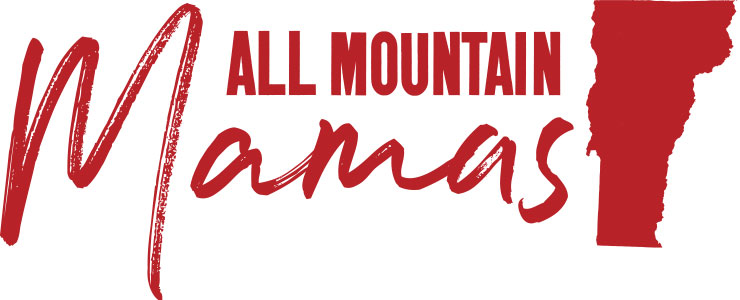Salt and pepper, cream and sugar, bread and butter, maple syrup and Vermont – some things are just meant to go together.

As a huge maple syrup aficionado (I put it in everything from my homemade bread and granola to salad dressing and sauces.) I was excited to go on the Sugar Maple Tour during a late winter stay at Trapp Family Lodge in Stowe. The tour promised to show me where the sugar maples were on the Lodge’s gorgeous 2500-acre property and to explain what happens on the journey from sap to syrup.
Although the tour is billed as family friendly, I was traveling solo that day as my husband and two teen sons had abandoned me to savor their last day of downhill skiing for the season.

(And because I like to keep it real as an All Mountain Mama, here’s a true confession: My kids should both wear bumper stickers that say “I’d rather be skiing” because all they want to do is go super fast. So I was more than happy to enjoy the tour at my own peaceful, pokey pace without them.)
The Trapp Family’s Maple Story
After I picked up my rental snowshoes, I joined the group of people waiting for our guide in a yurt that sits directly behind the Lodge’s Outdoor Center. Benches surrounded a cozy wood stove, making it tempting to snuggle up for a while.

But when our guide Bob came in and told us a bit of history about the Trapp family’s relationship to maple syrup, I couldn’t wait to get outside and see where it was made.
If you’re like most people, you probably remember the von Trapp family mostly for their singing courtesy of the movie The Sound of Music. And when the family came to America, they did tour and perform as the Trapp Family Singers. But to make money in their downtime, they also bought a working dairy farm on a hillside in Stowe, Vermont in 1942. The property came with a stand of sugar maple trees that were already a hundred years old – some of them had been had been tapped since 1850. Old growth trees like this were and are rare in Vermont, which was almost completely deforested by the turn of the twentieth century.

Since sugar maples don’t grow in Europe, the Trapp family had never tasted, let alone made, maple syrup but being industrious they quickly learned how to tap the trees themselves.
Eventually they abandoned dairy farming for the more lucrative hospitality business, but they never gave up farming the maple trees. In fact, some of the same trees they first used to make syrup are still standing today and are still being tapped for syrup with small taps and metal pails. Johannes von Trapp, the youngest son of Maria and Georg von Trapp still lives on the property and while he has conceded to modernity by allowing some of the trees to be permanently tapped with plastic tubing, he has also kept up some of the old ways.
“Johannes doesn’t like to see a lot of plastic when he goes into the forest,” Bob said, “so we tap 1400 trees with the tubing but 600 are still tapped by hand.”
Exploring The Sweetest Forest
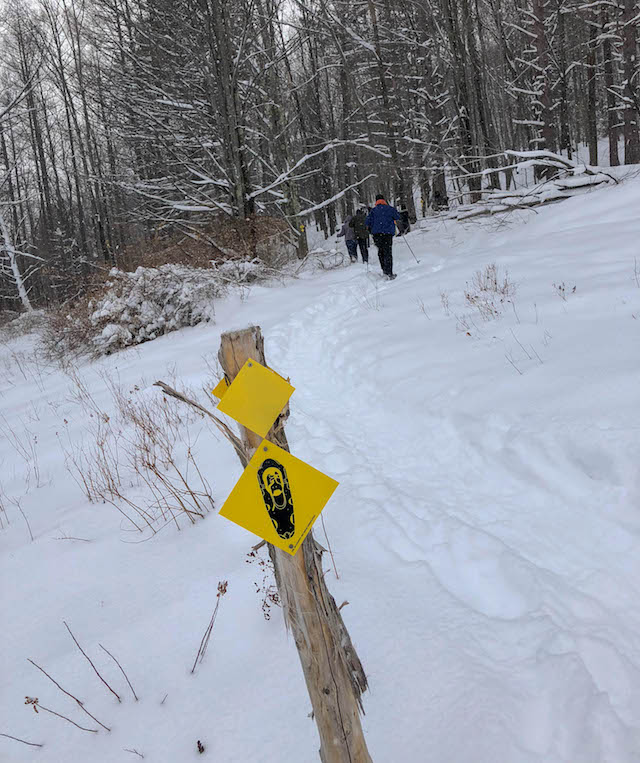
Almost as soon as we started the tour, I could see why Johannes might be picky. The platonic woods behind the Trapp Family Lodge were particularly beautiful on this March morning. A late winter snowfall left the birches, ash and maple trees surrounded with a fluffy white quilt. A pair of ravens soared overhead as our small group made it way toward the sugarbush – vernacular for stands of sugar maples that are ripe for tapping, as Bob told us.
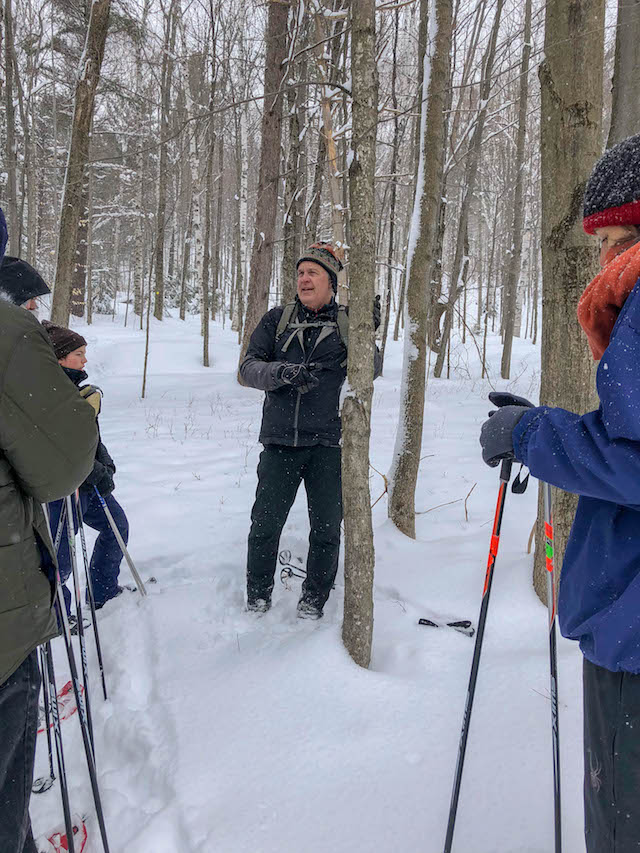
He first showed us how to identify sugar maples (an important skill in this line of work) by their bark and opposing branch structure.
We next stopped to check one of the buckets, but there was no telltale drip to show that the sap was running.
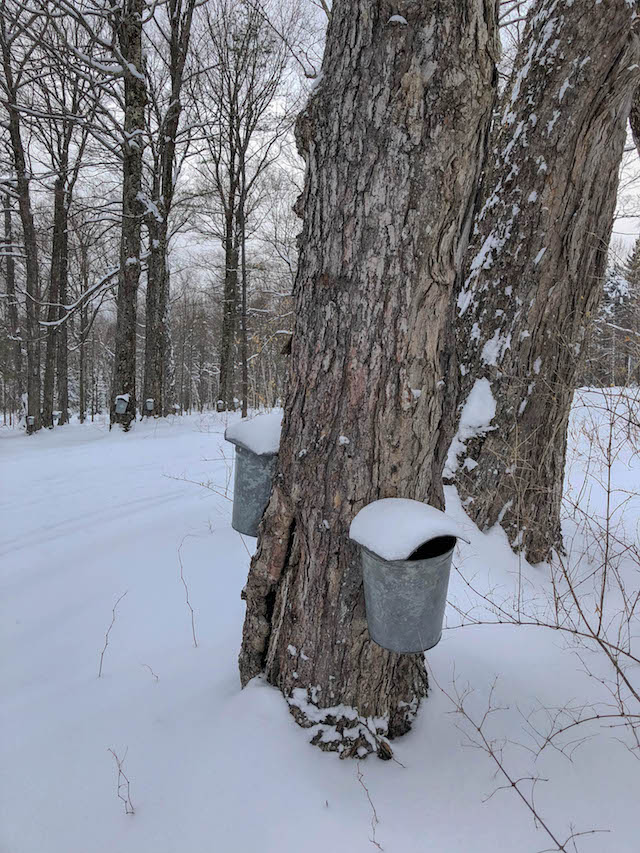
“It’s too cold for sap,” Bob explained, “For it to run the temperatures need to be in the forties during the day and the twenties at night.” (That would be in Fahrenheit; the Celsius equivalent would be around 4 degrees during the day and -6 at night.) When the weather is just so, a bucket can fill with sap in just 24 hours.
Although it was too chilly for us to hear the sap running on that day, Bob told us that a streak of warm weather in February of 2018 meant the staff had already made 300 gallons of syrup, the earliest that they had ever been able to do so.
The Home of Syrup Central
We continued on our way down the hill toward a long wooden building topped with a wooden cupola and a metal chimney. Like the trees that surrounded it, its roof wore a blanket of snow. This was the sugar house – otherwise known as syrup central – and we were invited to take off our snowshoes and come inside.
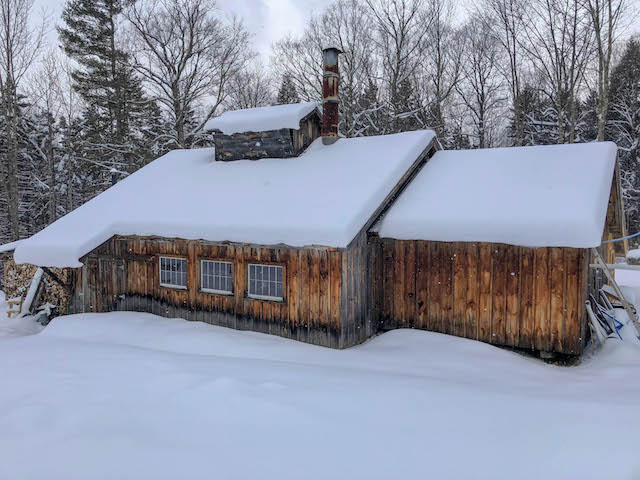
The floor was sticky under our boots as we wandered around looking at the evaporator where the sap – which is mostly water and about 2 percent sugar – is boiled into syrup – which is about 66.9 percent sugar.
Bob offered us each our own small cup of syrup to taste and proceeded to explain every step of the process, from showing us the specially cut extra long logs that are used to create a fire that’s about 1200 degrees…

…to the careful monitoring of the boiling saps temperature to make sure it’s at the right point…
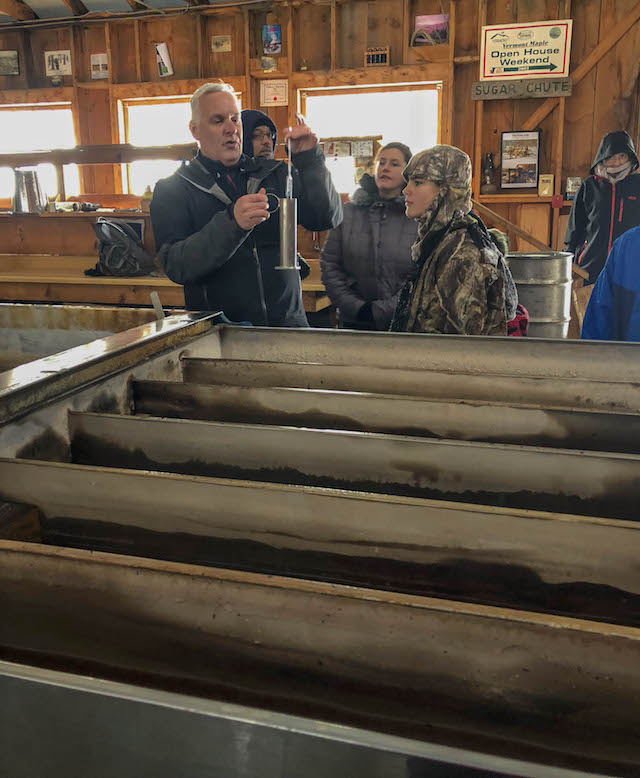
…to the filtering process at the end that eliminates a byproduct that’s called “maple sand” or niter and ends with the smooth, golden maple syrup inside sterile bottles.
The sugar house was like a maple syrup museum, with photos of the Trapp family at a sugar-on-snow celebration – a traditional syrup season party that involves eating maple syrup turned to chewy candy on snow, pickles for a sour bite, and salty homemade donuts to dip in warm syrup.
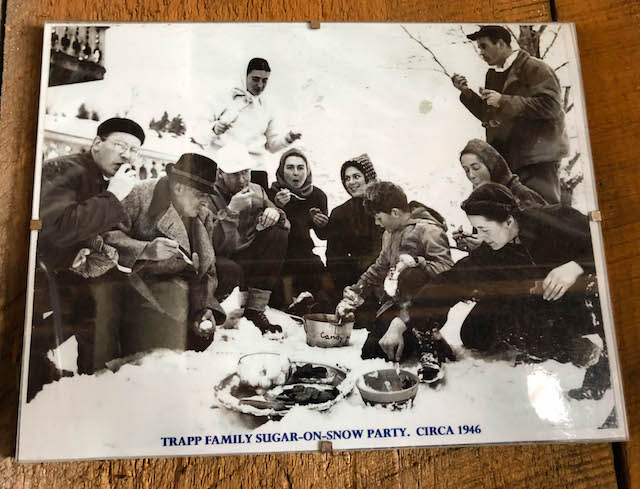
A tally of each year’s syrup production is written on the walls.

As reluctant as I was to head back to the real world outside this magical forest, I couldn’t wait to tell my boys the entire story of where their syrup came from the next time I served them pancakes. We will definitely be making a return visit so they can have a maple experience for themselves.
More information about Sugar Maple Tours at Trapp Family Lodge
- Sugar Maple Tours are offered year-round on Tuesdays, Wednesdays, Saturdays and Sundays at 10:30 a.m. (snowshoes are obviously not necessary in warmer months). If you would like to take the tour while syrup is being made, your best bet is to visit between the beginning of March and the end of April, although the season varies each year with the weather.
- The tour lasts about an hour and the hike out to the sugarhouse is not strenuous, although parents with very young children might consider bringing a backpack carrier. Small sleds called pulks are also available to rent for an hourly fee.
- There is a fee for the Sugar Maple Tour (it’s slightly less if you’re a guest of the resort) and snowshoes may be necessary depending on the trail conditions. These can be rented in the Outdoor Center if you don’t own a pair. Rentals are good for the whole day, leaving you time to explore the other snowshoe trails. There is also a fee for a trail pass if you are not a guest of the resort.
- If you’re hungry when the tour finishes around noon, there are a several excellent on-property lunch options including the Bierhall where you can sample Austrian specialties like wursts and spätzle as well as a variety of lagers brewed onsite and the Austrian Tea and Tap Room, which serves soups, salads, and more of that delicious beer. And don’t forget to buy some of the syrup you sampled at the Lodge’s gift shop or online.
- Other tours are also available; see the Trapp Family Lodge Activities Calendar for dates and times.
Mara Gorman may live at sea level now, but she’s a native New Englander and mountain aficionado who grew up skiing in Vermont. She spends as many days each winter as she can chasing her two teen boys through glades and across mogul fields and regularly journeys far and wide to get on the slopes. Mara blogs about her family’s many travel adventures at The Mother of all Trips. She is also the author of The Family Traveler’s Handbook and an award-winning freelance writer whose work has appeared in various USA Today print publications as well as on websites such as BBC Travel. When there’s no snow, Mara and her family can be found hiking, biking and eating around the United States and Europe.
